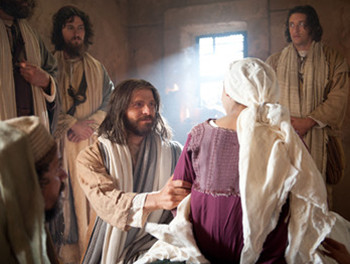The Synoptic Gospels (Mark, Matthew and Luke) told powerful stories about the life of Jesus and his message of hope. The early Christian communities who heard these stories passed them on because it was clear to them that important elements in the story would be relevant to anyone who had the eyes to see and the ears to hear. Jesus is simply and clearly available to people. And for us this is critically important. These stories emphasize the way people come to faith, how that faith moves them to action and how it leads them to discipleship.
 There’s a lot going on in the Scriptures today, as Mark presents us with a "story-within-a-story." First, there is an encounter between Jesus and a man named Jairus. But before that story concludes, another encounter takes place. The second, between Jesus and a nameless woman, runs its course, interrupting the first. Then finally we return for the conclusion of the story of Jairus. All three of the Synoptic writers give us their version of these encounters, so we should know that something significant is about to be told.
There’s a lot going on in the Scriptures today, as Mark presents us with a "story-within-a-story." First, there is an encounter between Jesus and a man named Jairus. But before that story concludes, another encounter takes place. The second, between Jesus and a nameless woman, runs its course, interrupting the first. Then finally we return for the conclusion of the story of Jairus. All three of the Synoptic writers give us their version of these encounters, so we should know that something significant is about to be told.
Jairus' agenda is simple and very urgent. His little daughter is at the point of death, and he feels utterly powerless. He has nothing to lose, yet his request is by no means hopeless or despairing. He simply requests: "Come and lay your hands on her, so that she may be made well, and live." He seems to know that if Jesus lays his hands on the girl, then she will live. Here is a person of faith. And faith, as we are told over and over in the Gospels, makes miracles.
Jesus not only responds immediately, but has reversed roles - Jairus leads, Jesus follows.
But just when we are being drawn deeply into this story, there is a sudden interruption.
"There was a woman," the Gospel tells us. She too confronts Jesus, but not in the same way that Jairus did. She was simply there. She was a woman - and therefore socially insignificant. But she is there, and therefore physically unavoidable. She, too, is a person of faith and believes that if she simply touches Jesus’ clothes, then she would be well. Her faith alone is enough to drive her into action and her faith immediately restores her to life.
No sooner has this woman been sent on her way than the first, unfinished story picks up again and moves toward its climax. Jairus is suddenly informed that his daughter has already died. Curiously, however, Jesus rather pointedly ignores the remark and offers words of encouragement: "Do not fear, only believe." Jairus has just witnessed belief-in-action, and its power to heal and overcome fear. Mark says nothing about his reaction. All we know is that along with Jesus and his three closest disciples Jairus hurries back home. Only this time Jesus leads and Jairus follows.
We know the rest of the story. At Jesus' touch, "immediately the little girl got up." We are struck by the speed with which things happen, and with the compassionate responsiveness of Jesus.
The Gospel adds that the dead girl was twelve years old, neatly linking her with the story of the sick woman, who had been afflicted for twelve years and was socially dead. In both cases not only are these two persons restored to physical health, but so also is their social identity as adult women.
There is a lesson here for us to learn. Faith without action is pointless. All we have to do is to be attentive to life around us, to visit the sick, to feed the hungry, to give drink to the thirsty, to care for the homeless and the oppressed. Because as long as we are close to the very least and discarded of this world, will we begin to understand that Jesus has come to involve everyone in his work of proclaiming that the reign of God has come.





